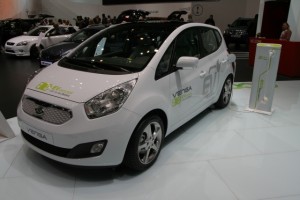 The evidence is mounting: electric cars are no more the impossible dream of a few forward-thinkers, they are instead set to become mainstream. The automotive industry is heading full throttle towards hybrid and eventually full electric propulsion, and there is no turning back. What was shown in Geneva highlighted the car industry’s increasing desire and necessity to catch consumers’ attention through style and sustainability, in the attempt –made by every carmaker – to move ahead of their old and new competitors in this looming, unprecedented rush to the automobile revolution. Car 2.0 is coming, and it’s the real thing, a world-changing game. So real that for the first time in many years new brands like Tesla can dream of threatening the market share of well established European makers. Some companies like Nissan-Renault got the message and skipped hybrids altogether to get ahead in the race for the bigger electric prize. Others are still shy and keep experimenting a variety of solutions. But more and more plug-in prototypes and new models are announced month after month. It’s a rush that cannot be stopped anymore, and there are more reasons to its increasing pace than just competition and fear of losing ground to competitors.
The evidence is mounting: electric cars are no more the impossible dream of a few forward-thinkers, they are instead set to become mainstream. The automotive industry is heading full throttle towards hybrid and eventually full electric propulsion, and there is no turning back. What was shown in Geneva highlighted the car industry’s increasing desire and necessity to catch consumers’ attention through style and sustainability, in the attempt –made by every carmaker – to move ahead of their old and new competitors in this looming, unprecedented rush to the automobile revolution. Car 2.0 is coming, and it’s the real thing, a world-changing game. So real that for the first time in many years new brands like Tesla can dream of threatening the market share of well established European makers. Some companies like Nissan-Renault got the message and skipped hybrids altogether to get ahead in the race for the bigger electric prize. Others are still shy and keep experimenting a variety of solutions. But more and more plug-in prototypes and new models are announced month after month. It’s a rush that cannot be stopped anymore, and there are more reasons to its increasing pace than just competition and fear of losing ground to competitors.
China and India, not Europe or the US, will play the crucial role. They are devoting increasing funds and long term plans to developing their own renewable energy industry, smart grid and of course electric cars. We have already seen what it means to a worldwide industry, be it wind or solar to name but two, when China or India weigh in (suffice to see last year’s installed wind capacity in China, or both China and India’s projected solar and wind capacities for the coming decade). What is it likely to happen to the car industry, when their own EVs and batteries will flood the market, and will be bought by millions of Indian and Chinese people in the first place? Without even trying to make up unpredictable figures, we can easily anticipate one adjective for their impact to the automotive market: huge.
And if Asia holds the key to the energy and car markets destiny, there is one more key ingredient to the future of cars, which is worth stressing. Electric vehicles, Car 2.0, are in their nature – and industrial/marketing development potential – much closer to IT gadgets than to traditional cars. They belong to the Information Technology market. Forget about moving parts, oil leaks, expensive engine maintenance, EVs are the next IT frenzy after mobile phones, laptops, iPods and the likes. Like any IT gadget, the main required operation will be to plug them when idle (something that’s fair to say most of us are already used to). Like laptops or smart phones, EVs will be multi-tasking tools, sending and receiving data through the smart electricity grid, and even displaying messages to the public through their metal skin (seen in Geneva). But unlike laptops and phones, they will also feed power to the grid when required (turning into a nation’s precious asset). Like any IT gadgets, we will keep them for as long as swapping batteries will make sense, only to replace them when a cooler, up to date model will storm the market.
And most importantly, as any other IT gadget, the learning curve of EVs will be far steeper and quicker than that of the old-fashioned manufacturing industry, leading to incredible improvements in a very limited timeframe: months, rather than years. Battery research, already in a booming frenzy, will see breakthrough results pouring in faster and faster, possibly fading away range anxiety well before EVs do become mainstream. If Nissan is already claiming it will give a 200 miles range to its Leaf EV by 2015, chances are better results could come in even earlier. More energy-dense, lighter and cheaper battery packs are just round the corner. The critical mass has been reached.
A lot of old-fashioned energy consultancy firms and automotive analysts, let alone the International Energy Agency, keep posting studies showing very low percentages for EVs penetration in the car market by 2020, or even 2030 or 2050 (the oil industry is particularly good at making these self-indulging long term predictions). They all miss the point: none of their projection models have built in the presence of new wildly powerful global market drivers (such as China or India, as suppliers and consumers), none of them seem to appreciate (purposedly?) the disruptive effect of even a slight under-supply of oil to the world’s economy and industry. All of them, finally, underestimate how customers could suddenly decide that electric cars are what they want to buy.






